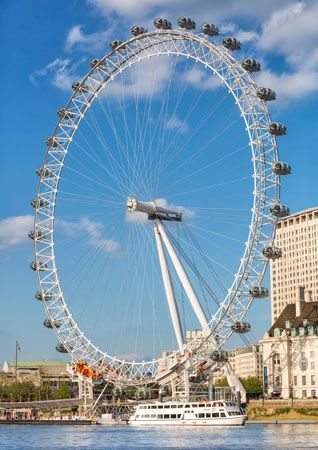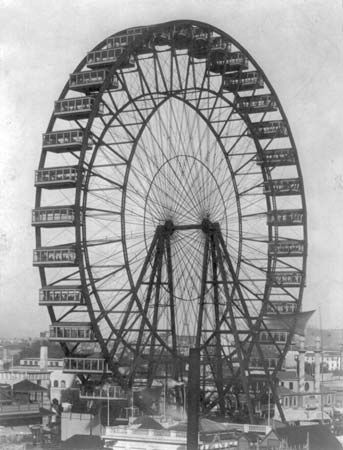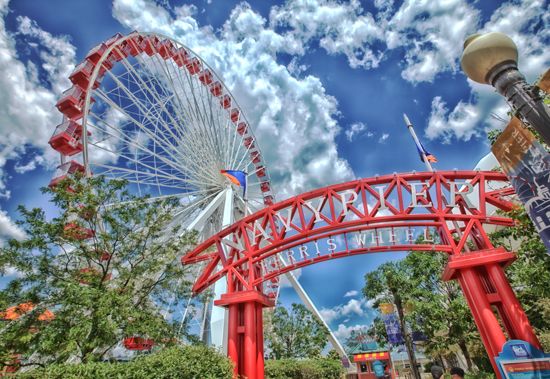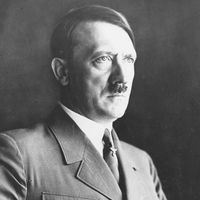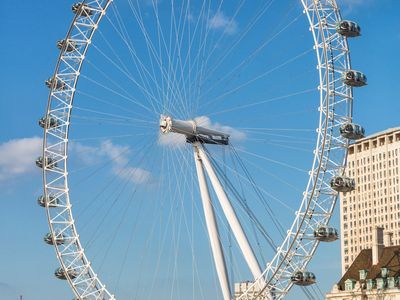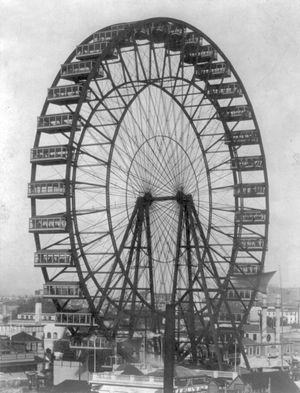Ferris wheel
Our editors will review what you’ve submitted and determine whether to revise the article.
Ferris wheel, popular amusement ride that typically consists of several seats, or cars, that rotate around a large axis. The Ferris wheel was invented by engineer George Washington Gale Ferris, Jr., for the World’s Columbian Exposition of 1893, which took place in Chicago. Sometimes called “observation wheels,” Ferris wheels are a common attraction at fairs, carnivals, and theme parks.
Origins at the Columbian Exposition
The Columbian Exposition was announced in 1888 to celebrate the 400th anniversary of Christopher Columbus’s voyage to America. Chicago was chosen to be the site of the exposition two years later. Renowned architect Daniel H. Burnham, who had made his reputation by designing some of the first skyscrapers in the world, was designated construction chief along with his colleague John W. Root (the latter, however, died in 1891). Burnham was surprised at the lack of interest in the Exposition among civil engineers in the United States and challenged them to create an attraction that would equal the 1,083-foot (330-meter) Eiffel Tower, which had wowed the world when it had debuted during the 1889 French Exposition in Paris.
Several ideas were put forth. One called for the construction of a tower that would dwarf Eiffel’s amazing architectural achievement, but it was rejected as a mere copycat. Another proposed a tower that would feature high-speed rails that visitors could toboggan down to return to their home cities. Ferris, a graduate of the Rensselaer Polytechnic Institute whose background was in railroads and mining, conceived of the idea of a giant revolving observation wheel, believing it would make for a popular attraction. He was inspired after riding a wooden observation wheel built by William Somers, who would later sue Ferris for stealing his idea (Somers won the initial suit but lost the appeal).
However, when Ferris approached the exposition’s ways and means committee in 1892 with his grand idea, he was ridiculed and called “The Man with Wheels in his Head.” The engineers on the committee believed that the wheel would be impossible to build and conveyed this to Ferris. Ferris, however, continued to advocate for his unconventional attraction, and on December 16, 1892, the committee finally granted him a concession to build the wheel on the midway on Central Avenue. The terms of the concession allowed Ferris’s company to keep the first $300,000 in ticket sales, after which the exposition would receive half the gross profits. Even though the country was in the throes of a severe economic depression, Ferris talked investors into funding the Ferris Wheel Company with $600,000 in capital.
Ferris had to act fast, because the exposition was scheduled to open in just four months. He hired fellow engineer Luther Rice as construction chief and sent out contracts for manufacturing the wheel’s many components, some of them huge in size, to several companies known for their precision work. Meanwhile, construction of the attraction’s massive concrete base was hindered by some of the most severe winter weather Chicago had seen in years. The ground was frozen for several feet underground and had to be thawed with pressurized steam, which was also used to keep the concrete from freezing before it could be poured. The wheel slowly came into being. Its massive axle, which was more than 45 feet (13.7 meters) long and weighed in at 89,320 pounds (40,515 kg), arrived on site on March 18, 1893, shipped to Chicago from Pittsburgh. Despite its massive size, it took workers just two hours to lift the axle onto its 140-foot- (42.7-meter-) high twin supports.
While the wheel was being assembled, which was already a complicated process, the plant that would power the attraction was being built outside the grounds. Two 1,000-horsepower reversible engines, driven by 10-inch (25.4-centimeter) steam pipes, were constructed to drive the wheel, one of which was held as an emergency replacement.
The Columbian Exposition opened its doors on May 1, 1893, but Ferris’s giant wheel, still sans cars, was not ready for its first test spin until June 9. The engines were powered up, and the wheel began its first revolution, which took 20 minutes. After a successful trial spin, the order was given to attach the wheel’s 36 cars, each of which was capable of holding 60 people, 38 of whom were able to sit. A second trial rotation was held on June 11, with Ferris’s wife, Margaret Ferris, aboard with six cars attached. Members of the press were given a turn to ride the wheel on June 13, resulting in effusive public praise for the unique attraction.
The wheel, glowing with the light of 3,000 incandescent light bulbs, opened to the public on June 21, 1893, with the blow of a golden whistle. A single rotation, which included six stops for loading passengers and took a total of 20 minutes, cost 50 cents. The view from the top was said to be “magnificent.”
“It is an indescribable sensation…that of revolving through such a vast orbit in a bird cage.”—Robert Graves, a reporter for the Alleghenian of Allegheny City (in what is now Pittsburgh)
The public fell in love with Ferris’s wheel, and by November 1, the last day of the exhibition, more than 1.4 million people had taken a spin. Afterward, the wheel languished until a new location near Chicago’s Lincoln Park neighborhood was announced. The wheel began running again, but paying customers were few, and the project quickly lost money. The wheel was purchased for $1,800 in June 1903, disassembled, and shipped to St. Louis as an attraction for the Louisiana Purchase Exposition of 1904. The wheel remained in St. Louis until the exposition ended and soon fell into disrepair. On May 11, 1906, it was finally felled with 200 pounds of dynamite.
Ferris did not witness the destruction of the attraction to which he had devoted most of his later years. Plagued by patent lawsuits and nearing bankruptcy, Ferris died from tuberculosis (though some sources state it was typhoid fever) on November 22, 1896.
Modern developments
Ferris did not live to see his idea become a part of American life, but his invention endured. Ferris wheels are a common attraction at festivals, carnivals, and fairs, and a quintessential symbol of summertime nostalgia. In 1995 Chicago’s Navy Pier revealed a new Ferris wheel, which was inspired by and commemorates Ferris’s original wheel. The 150-foot- (46-meter-) tall observation wheel featured 40 compartments. The Centennial Wheel, created to celebrate the pier’s 100th anniversary, replaced the 1995 wheel in 2016 and has a height of 196 feet (60 meters).
The Ferris wheel has also spread around the world. In 2000 London revealed its 443-foot- (135-meter-) tall London Eye, which takes visitors on an aerial tour of London’s skyline. It remained the tallest Ferris wheel in the world until it was surpassed by the Star of Nanchang in Nanchang, China. Most modern Ferris wheels use more advanced engineering than that of the first wheel, featuring electric motors and complicated gear mechanisms. Motors may help to keep individual cabins upright while the wheel spins.
- Ain Dubai: Bluewaters Island, Dubai. Height: 820 feet (250 meters).
- High Roller Observation Wheel: Las Vegas. Height: 550 feet (168 meters).
- Singapore Flyer: Marina Bay, Singapore. Height: 541 feet (165 meters).
- Star of Nanchang: Nanchang, China. Height: 525 feet (160 meters).
- London Eye: London. Height: 443 feet (135 meters).

